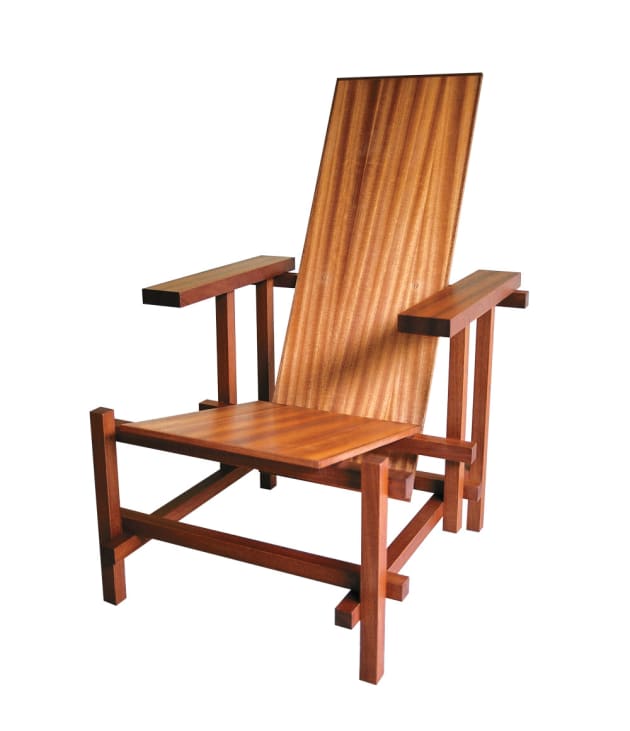Making the (Not) Red Blue Chair
Words and photos: John Winder
Gerrit Rietveld described his landmark building, as having the same aims as earlier realised in his Red Blue Chair. In his pre-architecture days, when furniture finishing and even much of its construction was individually crafted, Rietveld’s design work was exploring the possibility of mass production for a wider populace, as well as searching for an alternative to the tedium he had experienced doing fine work in his father’s furniture making business. Thus, the chair was developed so square sectioned framing members and arm-rests, all the same thickness, could be cut from one piece of timber, industrially, to be later assembled by a non-skilled person.

This was not characteristic of chairmaking at the time. His intention was to get innovative design to ordinary folk; in the end, the chair was never mass produced, and even today is made under licence mainly for collectors and style aficionados as it retails for $4000 in Australia*.
His rejection of the craftsmanship of the Arts and Crafts movement can be seen in the machine cut elements of the chair, to be put together like a toy construction set. Museum examples available today were not made to ‘magazine standard’; they used cheap timber, and most differ slightly one from the other, including some having shorter legs for those of us with shorter legs.
Distinctive joinery
Some argue the chair was a design innovation, although there may have been some influence from Frank Lloyd Wright’s chairs with the sloping back-rest passing down below the seat. But the ‘Cartesian node’, or Rietveld joint—without customary cut joint faces—was unusual if not new, by comprising three connecting components, each at right angles, and extending beyond the joint.
The joint is held together with two concealed and one through locking dowel. Similar joints were used in previous centuries, but those components did not extend beyond the joint, an arrangement which allows some latitude as to where the nodes occur so the chair could be made in a configuration to suit an individual. Custom made or not, a cushion for the lower back enhances the comfort.
Functional or decorative
This chair, like many of Rietveld’s furniture designs, is part decorative art and part useful furniture; in fact, painted, he intended his designs to decorate houses, perhaps substituting for the paintings you would hang on a wall, as he did in the pioneering open plan Rietveld Schroder house. The chair was first painted in its now famous red, blue, yellow and black in about 1923 as a contribution to the De Stijl art/design movement, but an early unpainted example is displayed in the Centraal Museum, Utrecht, originally owned by the first woman to be an attorney there.

Cartesian node: looking up from behind the left front leg.
The Red Blue chair is a chair of similar sized parts. His other pieces with Cartesian nodes included a sideboard, hanging lamp, child’s high chair and military chair; the chair designs evoking the form of the user. Several years later his furniture had changed to comprise boards crossing like intersecting planes, and evokes architectural more than human figures, as in the Berlin and Zigzag chairs.
Part of Rietveld’s design motivation was to make items which would not break up the room occupied by the furniture, or allow the pieces to enclose space. Instead, he’s reported as wanting a piece to share the space and leave it intact. So we can see how he has extracted only the essential elements of an armchair and then rebuilt these elements in a ‘transparent’ way. Early examples had a superfluous ‘sideboard’ under the arm rests.
Construction
The example shown here is made using the construction notes in Drijver’s book (see below), but with 30mm added to the bottom of the legs. The seat and back are 10mm plywood. Apart from these and the armrests, all components are 30mm square in section.

Tongue and groove edging for the plywood, before trimming flush.
They need to be finished to near final standard before the precisely positioned dowel holes are drilled, as any reduction in dimension from surface finishing at the joints after the dowel holes are drilled will leave gaps at the nodes. The position of some dowel holes is critical: for the vertical members the left and right pieces must be mirror images.
Dowelling pins were useful to position the four holes under the armrests. The back and seat are attached without glue, each with four countersunk screws covered with a glued-on plug.

An arm ready to be glued on.
All exposed dowels were made by hand, using a plane held upside down in a vice. After gluing, most dowels were pinned with 3mm bamboo skewers and the skewer holes plugged. This example is finished with a 50% mix of a tung oil floor finish and Danish oil.
The Red Blue chair dates from 1918, early in Rietveld’s career when he had established a furniture business independent of his father, and the chair is featured on the cover of more books about Rietveld and furniture design in general than any of his many other pieces.
* Reprinted from Wood Review magazine, issue 51, 2006.
Background information gathered from:
How to construct Rietveld furniture. Peter Drijver, Johannes Niemeijer. 2001. Overy P et al. The Rietveld Schroder House. Massachusetts Institute of Technology.1988.
Kuper M, van Zijl, I, Gerrit Th. Rietweld: the complete works. 1992, Princeton Architectural Press.
Baroni, D. Gerrit Thomas Rietveld furniture. 1978, Academy Editions.
When John Winder is not reading about or making furniture he works as a specialist medico. You can read his story about making Rietveld’s Zigzag chair here



